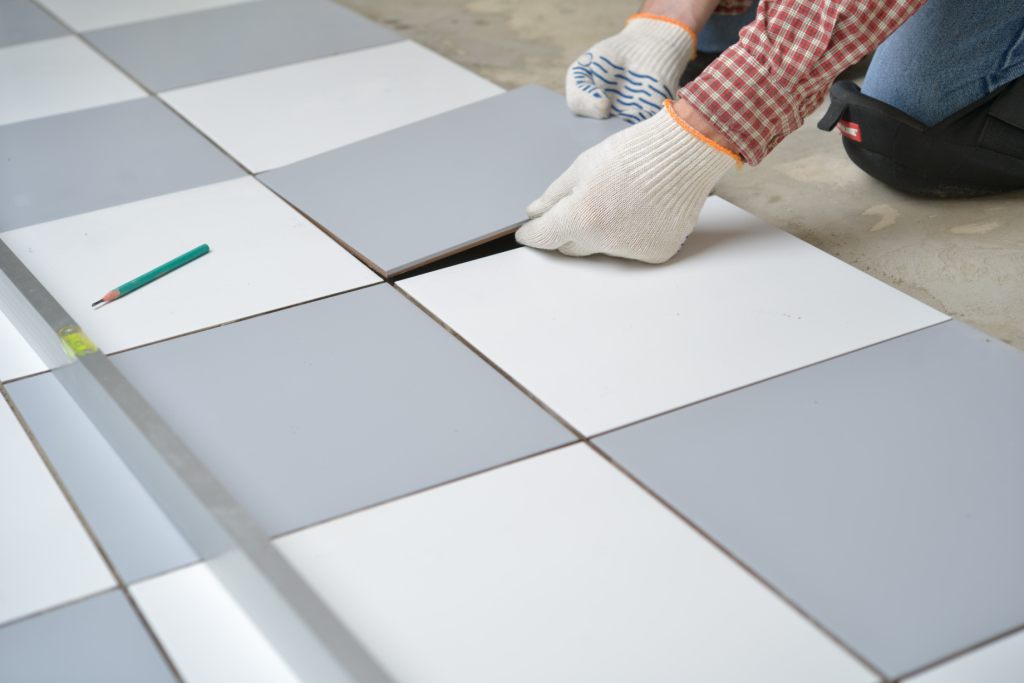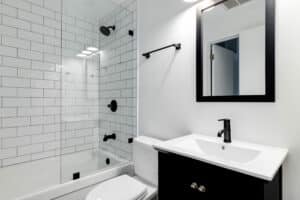Introduction to Tiling Renovation
Embarking on a renovation project can be both exciting and challenging. One of the key elements that play a crucial role in any renovation, particularly in areas such as the kitchen, bathroom, or flooring, is tiling.
Importance of Tiling in Renovation
Tiling serves both functional and aesthetic purposes in a renovation. It provides a durable and easy-to-clean surface, making it ideal for areas that are frequently exposed to water or heavy foot traffic. Aesthetically, tiles offer a wide range of design possibilities. The choice of tile material, color, size, and pattern can significantly influence the overall look and feel of the space. Whether one is aiming for a sleek, modern look with large-format porcelain tiles, or a classic, rustic charm with handmade ceramic tiles, tiling can transform a space. For more inspiration on tile selection, refer to our article on choosing the right tile for your kitchen: a guide.
Understanding the Costs of Tiling
While tiling can significantly enhance the appeal of a space, it’s important to understand the costs involved. The total cost of tiling a space is influenced by several factors, including the type of tile, the size of the area to be tiled, the complexity of the installation, and the cost of labor if hiring a professional.
Given the wide range of tile options available in the market, the cost of tiles can vary greatly. For instance, basic ceramic tiles can be relatively inexpensive, while high-end natural stone tiles can be quite costly.
In addition, the cost of installation can also vary depending on the complexity of the job. For instance, a simple, straight lay pattern might cost less compared to a more complex herringbone or mosaic pattern. Furthermore, additional features such as borders or inlays can also increase the cost.
Understanding these costs is crucial to effectively plan and budget for a tiling renovation. The goal is to achieve the desired outcome without breaking the bank. This article aims to guide individuals through the process of tiling on a budget, offering insights into affordable options for renovators.
Factors Affecting Tile Costs
The cost of tiling is influenced by numerous factors, with the type of material, size and shape of the tiles, and complexity of installation all playing significant roles. Understanding these variables can help individuals prioritize their budget and make informed decisions about their renovation projects.
Material Type
The type of material chosen for tiling directly impacts the overall cost. Common materials include ceramic, porcelain, and glass, each varying in price. High-end materials such as marble and granite are more expensive, but they also add a luxurious touch to the space. For those looking for budget-friendly options, ceramic and porcelain tiles offer durability and a wide range of design options. For more information on the different types of tiling materials and their advantages, check out our comprehensive guide on tiling.
Size and Shape
Tile size and shape also contribute to the total cost. Standard square and rectangular tiles are typically more affordable and easier to install than intricate shapes or large formats. Larger tiles require less grouting and create a modern, seamless look, but they may also need a more experienced installer. Smaller tiles, such as mosaics, may cost more due to the intensive labor required for installation. Our article on transforming spaces with creative tiling patterns provides more insight into how tile size and shape can influence the aesthetic of a space.
Installation Complexity
The complexity of the installation process can significantly influence the cost of a tiling project. Simple, straight patterns are less labor-intensive and therefore more cost-effective than intricate designs or patterns that require cutting tiles. The condition of the subfloor or walls, and whether they need preparation or repair before tiling, can also add to the cost. If you’re considering a DIY approach to save on labor costs, our article on DIY tiling mistakes to avoid for homeowners offers valuable tips.
Understanding the factors that affect tile costs can help in planning a renovation project that meets both aesthetic and budgetary requirements. Considering these elements when selecting tiles can lead to significant savings, making it possible to achieve a beautiful tiling transformation without breaking the bank.
Affordable Tiling Options
Keeping a renovation budget in check can be challenging, but selecting the right tiling options can significantly reduce overall costs. Here are three affordable tiling options that combine cost-effectiveness with aesthetic appeal and durability.
Ceramic Tiles
Ceramic tiles are a popular choice for those seeking tiling on a budget. Made from clay and hardened by heat, ceramic tiles offer a wide range of designs and finishes. They are easy to clean and maintain, making them ideal for areas like kitchens and bathrooms.
| Pros of Ceramic Tiles | Cons of Ceramic Tiles |
|---|---|
| Affordable | Can chip or crack |
| Versatile designs | Grout can stain |
| Easy to clean | Can feel cold underfoot |
For more information on using ceramic tiles in specific areas of the house, check out our guides on choosing the right tile for your kitchen and maximizing your space with expert tips for tiling small bathrooms.
Porcelain Tiles
Porcelain tiles are a type of ceramic tile made from denser clay and fired at higher temperatures. This makes them more durable and less porous than standard ceramic tiles. While slightly more expensive than ceramic tiles, their durability and low maintenance needs make them a cost-effective choice in the long run.
| Pros of Porcelain Tiles | Cons of Porcelain Tiles |
|---|---|
| Highly durable | Slightly more expensive than ceramic tiles |
| Low maintenance | Can be slippery when wet |
| Resistant to staining | Challenging to install |
If you’re interested in the latest trends in porcelain tiling, have a look at our article on the top 5 trends in tiling for 2023.
Glass Tiles
Glass tiles offer a modern and stylish look. They are resistant to stains, mold, and mildew, making them an excellent choice for areas exposed to moisture. Glass tiles reflect light, making spaces appear larger and brighter. While the initial cost may be higher, their longevity and low maintenance needs can make them a budget-friendly option over time.
| Pros of Glass Tiles | Cons of Glass Tiles |
|---|---|
| Modern look | Higher initial cost |
| Resistant to stains, mold, and mildew | Can chip or scratch |
| Reflects light | Difficult to install |
For more insights on making the most out of your tiling renovation, explore our articles on DIY tiling mistakes to avoid for homeowners and how to maintain your tiled surfaces with easy cleaning tips.
When considering tiling on a budget, remember that the cost of tiles is just one aspect to consider. Installation costs, maintenance, and durability should also factor into your decision. By exploring these affordable tiling options, you can achieve a renovation that balances cost, style, and functionality.
Cost-Saving Tips for Tiling
When renovating on a budget, it’s essential to find ways to cut costs without compromising quality. Here are a few strategies that can help keep tiling costs manageable.
Reusing Existing Tiles
One of the most effective ways to save money when tiling is to reuse existing tiles. If the tiles are still in good condition, they can be carefully removed, cleaned, and reinstalled. This not only saves on the cost of new tiles but also reduces waste, making it an eco-friendly option. For tips on how to maintain and clean your tiles, refer to our article on how to maintain your tiled surfaces.
Choosing Standard Sizes
Tiles come in a variety of sizes, but standard-sized tiles generally cost less than custom sizes. By choosing standard sizes, you can significantly reduce the cost of your tiling project. Furthermore, standard-sized tiles are typically easier to install, which can save on labor costs as well. For more on choosing the right tile size, check out our guide on choosing the right tile for your kitchen.
Simplifying Installation Patterns
Complex installation patterns can add a unique visual appeal to your space, but they also require more time and skill to install, which can increase the cost. By opting for simpler installation patterns, you can keep labor costs to a minimum. Nevertheless, even simple patterns can look stylish and sophisticated when done right. For inspiration on how to transform your space with creative tiling patterns, visit our article on transforming spaces with creative tiling patterns.
By implementing these cost-saving strategies, it’s possible to carry out a successful tiling renovation without breaking the bank. Whether you’re tiling a kitchen, bathroom, or other space, these tips can help you achieve a beautiful result on a budget.
Professional Tiling vs. DIY
When considering tiling for a renovation project, one of the main decisions to make is whether to hire a professional or attempt a do-it-yourself (DIY) project. Both options have their advantages and potential savings, depending on the specific needs and skills of the individual.
When to Hire a Professional
Professional tiling contractors bring expertise and experience to the project. They can handle complex patterns, large areas, and intricate cuts with ease, ensuring a polished, professional finish. They are also well acquainted with the best practices for tiling, from understanding tile adhesives to mastering grouting techniques for perfect finishes every time.
Hiring a professional is advisable when dealing with expensive tiles, as a mistake can lead to significant wastage. It’s also a good idea to hire a professional if time is a constraint, as they can complete the job more quickly than a novice DIYer.
When to Consider DIY
For individuals with a knack for handiwork, DIY tiling can be a cost-effective alternative. It’s a suitable choice for small, simple projects, such as a backsplash or small bathroom floor. DIY is also an option for those looking to learn a new skill or who enjoy the satisfaction of completing a project themselves.
Before embarking on a DIY tiling project, it’s important to learn the basics of tiling, from choosing the right tile for your space to understanding the installation process. Our articles on choosing the right tile for your kitchen and maximize your space: expert tips for tiling small bathrooms offer great starting points. Be sure to also check out our piece on DIY tiling mistakes to avoid for homeowners to help ensure a successful project.
Potential Savings with DIY Tiling
Taking on a DIY tiling project can result in substantial savings, primarily by eliminating the cost of labor. However, these savings need to be weighed against the potential for costly mistakes and the time investment required.
Here’s a simple comparison of potential costs for a hypothetical 100 sq ft tiling project:
| Cost Component | Professional Tiling ($) | DIY Tiling ($) |
|---|---|---|
| Tiles | 200 | 200 |
| Adhesive, Grout & Supplies | 50 | 50 |
| Labor | 500 | 0 |
| Total Cost | 750 | 250 |
As seen in the table, DIY tiling can lead to savings of up to 67%. However, it’s important to remember that these figures are hypothetical, and actual costs can vary widely based on tile choice, project complexity, geographic location, and other factors.
Whether opting for professional or DIY tiling, it’s essential to approach the project with a clear understanding of the process, costs, and potential challenges. Armed with this knowledge, one can make an informed decision that best suits their budget and renovation goals.
Smart Shopping for Tiles
In the quest to achieve a cost-effective renovation, smart shopping plays a significant role. When it comes to tiling, there are a few strategies that can help you keep your expenses down without compromising on quality or aesthetics.
Buying in Bulk
Buying tiles in bulk is a strategy that can significantly reduce the cost per unit. Retailers often offer discounts when you purchase large quantities, as it allows them to clear inventory and reduce storage costs. This approach works particularly well if you’re undertaking a large renovation project or require tiles for multiple spaces. Remember, it’s always a good idea to buy additional tiles to cover breakages or future replacements.
Shopping Sales and Clearance
Often, retailers will host sales or clearance events to make room for new inventory. These events provide an excellent opportunity to purchase high-quality tiles at a fraction of the original cost. Regularly checking websites and subscribing to newsletters can keep you informed about such events.
Considering Seconds or Overstock Tiles
Seconds or overstock tiles are those that have minor imperfections or are leftover from large orders. These tiles are typically sold at a reduced price, making them a cost-effective option for those tiling on a budget. The imperfections can be minor color variations or small chips, which are often unnoticeable once installed.
However, it’s essential to ensure that these imperfections won’t affect the durability or overall look of your tiling. It’s also important to buy extra tiles in this case, as finding a match later might be difficult if the tiles are from an overstock or discontinued line.
Overall, smart shopping can make a significant difference in managing the costs of your tiling project. By buying in bulk, shopping sales, and considering seconds or overstock tiles, you can save money while still achieving the desired look for your renovation. For more insights into tiling, check out our other articles on choosing the right tile for your kitchen, maximize your space: expert tips for tiling small bathrooms, and the top 5 trends in tiling for 2023.




